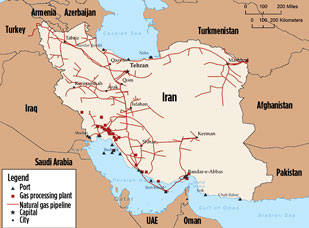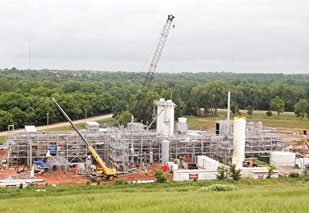Regional Perspectives
E. Salehi, APED Engineering Consultants, Calgary, Alberta, Canada
Iran has the world’s largest proven natural gas reserves at 1,201 Tcf, according to BP’s Statistical Review of World Energy,1 and it is the fourth-largest natural gas producer in the world. However, it exports only small amounts of natural gas to Azerbaijan, Armenia and Turkey—approximately 9 Bcmy. Potential exists for Iran to export approximately 30 Bcmy to the EU over the long term with the development of LNG facilities.
Iran has so far prioritized its gas allocation to satisfy domestic demand for heat, power and industry use, and for reinjection to aging oil fields to maintain production. With new phases of the giant South Pars gas field coming onstream, however, any surplus gas will need to be monetized through pipeline export, petrochemical use, gas-to-power, LNG and/or GTL (Fig. 1).
 |
|
Fig. 1. Iran’s existing natural gas infrastructure. |
Iran has demonstrated impressive development in the petrochemical and gas-to-power industries. However, no significant movement has been seen on LNG or GTL. The question remains of which option will be the best pathway for the monetization of Iran’s gas reserves.
Iran needs to invest in both LNG and GTL technologies; however, better opportunities exist to develop GTL over LNG. The country could become a global GTL hub if it is willing to embrace emerging and smaller-scale technologies.
Saturated LNG market. The global LNG market is oversupplied, and is expected to remain so until 2025 due to the large number of LNG plants anticipated to come onstream in Australia and the US. Slowdowns in LNG demand from China, Japan and South Korea are magnifying this supply glut. As a result, project developers are hesitant to commit over the near term to capital-intensive liquefaction projects. Financing may become more of a challenge if oil prices remain low.
According to BP statistics,1 global liquefaction capacity is more than 300 MMtpy, with another 130 MMtpy of capacity under construction. More than 60 LNG projects with a combined liquefaction capacity of 650 MMtpy are expected to compete for market share between 2020 and 2025. The majority of these projects are located in the US, Canada and Australia. By contrast, worldwide LNG demand has hovered at 240 MMtpy over the last few years.
For Iran to compete with these large, emerging LNG players, it would need to include LNG buyers in the ownership structure of its liquefaction projects. However, LNG is not necessarily the most economic or practical option for Iran to monetize its natural gas in the present market situation. The LNG market will continue to be oversaturated in the foreseeable future, and it will be a challenge for Iran to finance LNG projects.
Potential in small-scale GTL. The country has a much better chance of becoming a hub for GTL. Only five commercial GTL plants are in operation around the world. All are licensed by either Sasol or Shell and are located in South Africa, Nigeria, Malaysia and Qatar, with a combined production capacity of 260 Mbpd.
Sasol and Shell are the pioneers of the GTL industry, although other GTL technology licensors in the market include Air Liquide/Lurgi and BP/Davy Process Technology. However, neither partnership operates a GTL plant at commercial scale.
The next tier of GTL technology licensors are emerging technology companies that provide mini- and micro-scale GTL technologies. These technologies are more efficient compared to conventional GTL technologies, and they are cost-effective for smaller-scale applications like associated gas flaring. In line with the shale boom in North America, tremendous advances have been made in small-scale GTL technology over the past decade (Fig. 2).
 |
|
Fig. 2. Small-scale GTL projects, like the ENVIA Energy GTL |
These smaller-scale technologies convert less-valuable natural gas and associated gases into higher-value liquid products. At present, large oil and gas companies are evaluating options for investment in these technologies. Iran could potentially invest in, or acquire, some of these game-changing emerging technology companies.
Actions for Iran. Although larger-scale GTL projects are economically challenging in the present price environment of below-$50/bbl oil (as of the time of publication), Iran needs to develop a long-term plan for GTL in its natural gas downstream sector.
One step toward creating a GTL hub in Iran would be to establish a team of experts inside the oil ministry. This team would comprise a mix of market and business analysts, as well as engineers with specialties in natural gas monetization techniques. It would define Iran’s natural gas monetization roadmap and consult the oil minister on development options.
The team would also be responsible for evaluating the most feasible alternatives for Iran’s natural gas monetization, including residential, industrial, enhanced oil recovery, pipeline export, petrochemical, gas-to-power, GTL, LNG and other options. It is recommended that the team members seek expertise from world-scale consulting firms.
Lastly, Iran should carefully watch how Qatar is changing its strategy for gas export development amid the downturn in the oil and gas market. Qatar’s actions could serve as a regional model for Iran’s development of its new gas reserves going forward. GP
Literature cited
1 BP, BP Statistical Review of World Energy, June 2015, available online: https://www.bp.com/content/dam/bp/pdf/energy-economics/statistical-review-2015/bp-statistical-review-of-world-energy-2015-full-report.pdf
 |
Ebrahim Salehi is a business development and project director at APED Engineering Consultants. He is a chemical engineer with over 10 years of oil and gas industry experience within operating and EPC companies. Dr. Salehi’s specific areas of expertise include flare gas recovery, natural gas monetization, conventional and unconventional oil and gas field development, and biofuels. His strong research and development background, combined with a big-picture understanding of the oil and gas market, has also led to publication of several articles and patents. He holds a PhD in chemical engineering from the University of Calgary.




Comments